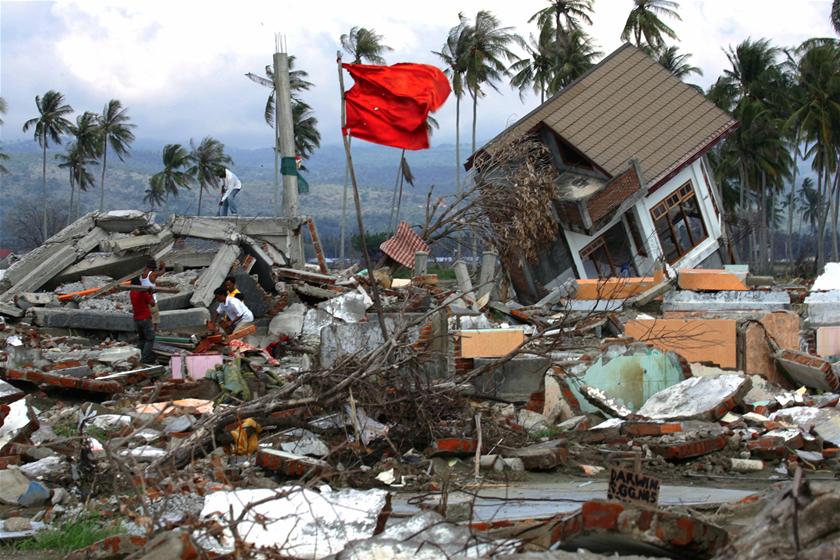The toll from an earthquake and tsunami in Indonesia soared to 832 confirmed dead, with authorities fearing the numbers will climb as rescuers grappled to get aid to outlying communities cut off from communications and help.
Dozens of people were reported to be trapped in the rubble of several hotels and a mall in the city of Palu, on Sulawesi island, which was hit by waves as high as six metres (20 feet) following the 7.5 magnitude earthquake on Friday.
A woman was pulled alive from the debris of the city’s Roa Roa Hotel, where up to 60 people were believed trapped. Hundreds of people gathered at the wrecked eight-storey Tatura Mall searching for loved ones.
“Grieve for the people of Central Sulawesi, we all grieve together,” President Joko Widodo tweeted late on Sunday.
Most of the confirmed deaths were in Palu itself, and authorities are bracing for the toll to climb as connections with outlying areas are restored.
Of particular concern is Donggala, a region of 300,000 people north of Palu and close to the epicentre of the quake, and two other districts, which has been cut off from communications since Friday.
“We haven’t received reports from the three other areas. Communication is still down, power is still out. We don’t know for sure what is the impact,” Sutopo Purwo Nugroho, a spokesman for the National Disaster Mitigation Agency, told a news conference.
Along with Palu, 1,500 km (930 miles) northeast of Jakarta, these districts have a combined population of about 1.4 million.
Social worker Lian Gogali tweeted from the area that several villages on the west coast of Sulawesi were in desperate need of food, medicine and shelter and that road access was still limited.
PLEDGE TO REBUILD
Five foreigners – three French, one South Korean and one Malaysian – were among the missing, Nugroho said. The 832 dead included people crushed in the quake and swept away by the tsunami.
Vice President Jusuf Kalla said the death toll could rise into the thousands.
Earlier President Widodo visited a housing complex flattened when the quake liquefied the soil it stood on, and called for patience.
“I know there are many problems that need to be solved in a short time, including communications,” he said. The ruins would be rebuilt, he said, as aftershocks rattled the region 48 hours after the quake.
Footage of the ruined city show a crumpled mess of houses, cars and trees mashed together by the quake, with rooftops and roads split and left at all angles.
Internal Affairs Minister Tjahjo Kumolo, asked about reports of looting on social media, said he had ordered authorities to help people get food and drink and businesses would be compensated. One video posted on YouTube showed people grabbing boxes of supplies from a truck.
Television pictures showed scores of residents shouting “we’re hungry, we need food” as soldiers distributed rations from a truck in one neighbourhood, while footage from elsewhere showed people making off with clothes and other items from a wrecked mall.
State logistics agency chief Budi Waseso said it was preparing to send hundreds of tonnes of government rice stocks to Central Sulawesi areas affected by the disaster.
Finance Minister Sri Mulyani Indrawati said the government had allocated 560 billion rupiah ($37.58 million) for disaster recovery, media reported.
QUESTIONS ABOUT WARNINGS
Indonesia, which sits on the seismically active Pacific Ring of Fire, is all too familiar with deadly earthquakes and tsunamis. In 2004, a quake off Sumatra island triggered a tsunami across the Indian Ocean, killing 226,000 people in 13 countries, including more than 120,000 in Indonesia.
Questions are sure to be asked why warning systems set up after that disaster appear to have failed on Friday. Nugroho, bemoaning a fall in funding, said no tsunami buoys, one type of instrument used to detect the waves, in Indonesia had been operating since 2012.
The meteorological and geophysics agency BMKG issued a tsunami warning after the quake but lifted it 34 minutes later, drawing criticism it had been too hasty. But officials estimated the waves had hit while the warning was in force.
Hundreds of people had gathered for a festival on Palu’s beach when the water surged. A disaster official said the tsunami travelled across the sea at speeds of 800 kph (500 mph).
Video on social media showed water bearing whirls of debris rushing in as people shouted in alarm and scattered.
Palu is at the head of a bay, about 10 km long and 2 km wide, which had “amplified” the wave as it was funnelled towards the city, a geophysics agency official said.
The BMKG said its closest tidal gauge sensor, about 200 km (125 miles) from Palu, had only recorded an “insignificant” 6 cm (2.5 inches) wave.
Palu’s airport was damaged in the quake, but had reopened for limited commercial flights, authorities said.
Neighbours including Australia, Thailand and China offered help and Pope Francis, speaking to thousands in St. Peter’s Square, said he was praying for the victims.
Indonesia has the world’s largest Muslim population but also significant pockets of Christians, including on Sulawesi, which is one of the archipelago nation’s five main islands.







